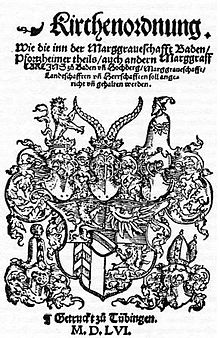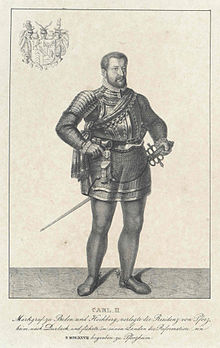Charles II (Baden-Durlach)
Margrave Karl II. (* July 24, 1529 in Pforzheim ; † March 23, 1577 in Durlach ; called Karle mit der Tasch ) ruled the margraviate of Baden-Durlach from 1552 to 1577. On June 1, 1556, Karl had a new church ordinance proclaimed, with which the Lutheran creed was introduced ( Reformation ), and in 1565 moved the residence from Pforzheim to Durlach.
Life
Karl was the son of Margrave Ernst I of Baden-Durlach and his second wife Ursula von Rosenfeld . As the offspring of this morganatic marriage , its ability to succession was controversial. Nevertheless, in September 1552 he succeeded his father in the upper margraviate . Only after his half-brother, Bernhard IV. , Who was twelve years his senior , died on January 20, 1553, and a few days later on February 6, his father too, could Karl take over the government of the entire margraviate of Baden-Pforzheim (later Baden-Durlach).
The introduction of the Reformation in 1556
After the Passau Treaty (1552), a number of secular rulers in southwest Germany introduced the Reformation. Margrave Ernst von Baden-Durlach is also said to have had plans for this, but continued to shy away from a possible conflict with the regent of the Catholic Front Austria , Archduke Ferdinand , who again registered his claims to areas of the Baden Oberland .
Margrave Karl II. - like his cousin Margrave Philibert of Baden-Baden - was very committed to the Augsburg Religious Peace of 1555 at the Reichstag , which allowed the secular imperial estates to introduce the Reformation. With this security and at the urging of Duke Christoph von Württemberg , Karl then dared to introduce the Reformation in the margraviate of Baden-Durlach by issuing a new church ordinance on June 1, 1556.
The preparation of the Reformation and the drafting of the church ordinance was entrusted to a commission chaired by the Chancellor of the Margraviate of Baden (Pforzheimer part), Martin Achtsynit . Members of the commission were the Tübingen theologian Jacob Andreae , as well as the Saxon theologians Maximilian Mörlin and Johann Stössel , as well as the Heidelberg court preacher Michael Diller. In addition to the theologians, the commission included the margravial Baden court councilors Johann Sechel and Georg Renz. Achtsynit also became the first director of the council of churches; Karl himself was the regional bishop of the Protestant Church and thus succeeded the bishops of Strasbourg, Speyer and Constance who were previously responsible for parts of his rule. The “turmoil within the evangelical creed” also impaired the work of the commission. Ultimately, for political reasons, the church order of Württemberg, which was designed by Johannes Brenz in 1553, was largely adopted . For the first church visit , which was carried out in autumn 1556, Württemberg also made Jacob Heerbrand available, who was also involved in the final editing of the church regulations. For the Baden Oberland , Karl appointed the Basel theologian Simon Sulzer as general superintendent .
Frequent visitations were intended to ensure that only Lutheran pastors were active and that church regulations were observed. Numerous Catholic pastors were expelled. Ferdinand of Austria formally denied Karl the right to introduce the Reformation in his Breisgau dominions.
The zeal that Karl developed with the introduction of the Reformation earned him the nickname “the pious” among the people.
As a result, the " Ernestine Line " split shortly after the division of the country in terms of faith. When the two margraviates came together again under Margrave Karl Friedrich through succession in 1771 , he had the foresight and sovereignty to admit several faiths and to call for acceptance and tolerance.
In 1561 the margrave confessed to the unchanged Augsburg Confession on the occasion of a Protestant convention in Naumburg organized by Elector August von Sachsen .
Just like his cousin Margrave Philibert of Baden-Baden, he helped Charles IX. of France by sending auxiliary troops in the war against the Calvinist Huguenots .
The prelate dispute
As a result of the Reformation, only Lutheran pastors were allowed in the territory of the Margrave of Baden-Durlach. However, the church set was in many cases owned by Catholic monasteries and orders, which were now supposed to appoint and pay a Lutheran pastor, which of course provoked resistance. In the Augsburg Religious Peace this case was actually clearly regulated. On the one hand, they were allowed to keep and use their properties in Protestant areas, but had to maintain them for the Protestant pastors. However, due to the Habsburgs' sovereignty claims to the Upper Baden rulers described above, the prelates believed that they would not have to fulfill the maintenance obligation for pastors and churches in Protestant churches , but they wanted to keep church tithes - the levy that was intended for the maintenance of the pastors. Karl therefore confiscated the prelates' goods and used them to finance the maintenance of pastors and churches. Johann Ulrich Zasius negotiated a compromise with Baden-Durlach, according to which the confiscated goods were released, but the funds necessary for the parish salary could be retained. However, the Austrian authorities in Innsbruck did not recognize this contract and escalated the dispute. After some prelates reached a bilateral agreement with Baden-Durlach, general negotiations got underway again and on April 24, 1561 led to the Treaty of Neuchâtel am Rhein, which essentially followed the treaty already negotiated by Zasius.
The relocation of the residence to Durlach in 1565
In 1565 the margrave moved the residence from Pforzheim to Durlach . This happened due to a dispute with the Pforzheim citizens when they did not want to act as drivers in a hunt organized by the margrave at the rifle festival. In the literature, however, it is pointed out that rather more rational reasons - namely Durlach's more central location in the Baden Unterland - were decisive for the decision.
In this context, the existing hunting lodge in Durlach was expanded into Karlsburg . The client supervised the expansion himself and personally rewarded the workers from the shoulder bag he carried. From this the affectionate nickname "Karle mit der Tasch" developed. As a result, Durlach was also renovated as a city, the castle was given a castle garden and the city was rounded off with additional gates and, as was common with regent cities at the time, was given a mint in 1571 .
The sons
Of his sons, only Georg Friedrich remained Lutheran , Ernst Friedrich converted to Calvinism and Jakob III. became catholic . Since Georg Friedrich lived the longest, the margraviate ultimately remained Lutheran. After the margrave's death, the mother ran the affairs of state in a guardianship government for seven years , until the sons reached the rulable age.
Marriages and offspring
In his first marriage, the margrave married on March 10, 1551 Kunigunde von Brandenburg-Kulmbach (* June 17, 1523, † February 27, 1558), the daughter of the margrave Casimir von Brandenburg-Kulmbach . The following children were born from this marriage:
- Marie (January 3, 1553 - November 11, 1561)
- Albrecht (June 12, 1555 - May 5, 1574)
In his second marriage, Margrave Karl II married Anna von Veldenz (November 12, 1540 - March 30, 1586) on August 1, 1558 , the daughter of Count Palatine Ruprecht von Veldenz . The following children were born from this marriage:
- Dorothea Ursula (born June 20, 1559 - † May 19, 1583), married Ludwig III on November 7, 1575 . of Württemberg (January 1, 1554 - August 28, 1593)
- Ernst Friedrich (October 17, 1560 - April 14, 1604), married Anna von Ostfriesland on December 21, 1585 (May 26, 1562 - April 21, 1621), the daughter of Count Edzard II of East Friesland
- Jacob III (* May 26, 1562; † August 17, 1590), married on September 6, 1584 Elisabeth von Pallandt- Culemborg (* around 1567; † May 8, 1620), the daughter of Count Florence I von Pallandt-Culemborg (1537 -1598); ruling margrave
- Anna Marie (August 4, 1565 - October 8, 1573)
- Elisabeth (September 27, 1570 - October 6, 1611)
- Georg Friedrich (born January 30, 1573; † September 24, 1638); ruling margrave
See also
literature
- Rudolf Burger: The Reformation in the Markgräflerland. Private print, Weil am Rhein 1984.
- Joseph Elble: The introduction of the Reformation in the Markgräflerland and in Hochberg. 1556-1561. In: Freiburg Diocesan Archive. Volume 42, 1914, pp. 1-110 ( online at the University of Freiburg ).
- Arthur Kleinschmidt : Karl II., Margrave of Baden-Durlach . In: Allgemeine Deutsche Biographie (ADB). Volume 15, Duncker & Humblot, Leipzig 1882, pp. 233-237.
- Johann Pflüger: History of the city of Pforzheim. Reprint of the edition Pforzheim, Flammer, 1862. Riecker, Pforzheim 1989, ISBN 3-9802239-0-6 ( limited preview in the Google book search).
- Hans Jürgen Rieckenberg: Karl II .. In: New German Biography (NDB). Volume 11, Duncker & Humblot, Berlin 1977, ISBN 3-428-00192-3 , p. 220 f. ( Digitized version ).
- Johann Christian Sachs : Introduction to the history of the Marggravschaft and the Marggravial old princely house of Baden . Fourth part. Lotter, Carlsruhe 1770, p. 77–184 ( limited preview in Google Book search).
- Karl Friedrich Vierordt : History of the Protestant Church in the Grand Duchy of Baden. Volume 1: Up to the year 1571. Braun, Karlsruhe 1847 ( limited preview in the Google book search), pp. 420–441.
- Udo Wennemuth (Ed.): 450 years of the Reformation in Baden and the Electoral Palatinate. Kohlhammer, Stuttgart 2009, ISBN 978-3-17-020722-6 .
- Ernst Walter Zeeden : Small Reformation History of Baden-Durlach and Electoral Palatinate. A brief overview of the beginning of the Reformation and the fortunes of the Catholic Church in the margraviate of Baden-Durlach and the Electoral Palatinate. Badenia, Karlsruhe 1956.
Individual evidence
- ↑ s. Vierordt p. 420
- ↑ s. Burger p. 24
- ↑ s. Vierordt p. 429
- ↑ s. Burger p. 27
- ↑ Burger p. 27
- ↑ z. B. St. Blasien , All Saints' Day, St. Peter, Schuttern, Tennenbach, Waldkirch
- ↑ z. B. the Teutonic Order
- ↑ s. Burger pp. 65-70
- ↑ s. Pflüger p. 276 f.
Web links
- Works by and about Charles II in the German Digital Library
- Picture of Karl II. Von Baden-Durlach in: Picture archive Photo Marburg - Picture index of art and architecture
| predecessor | Office | Successor |
|---|---|---|
| Ernst I. |
Margrave of Baden-Durlach 1553–1577 |
Anna von Veldenz |
| personal data | |
|---|---|
| SURNAME | Charles II |
| ALTERNATIVE NAMES | Karle with the bag |
| BRIEF DESCRIPTION | Margrave of Baden-Durlach |
| DATE OF BIRTH | July 24, 1529 |
| PLACE OF BIRTH | Pforzheim |
| DATE OF DEATH | March 23, 1577 |
| Place of death | Durlach |

